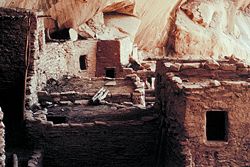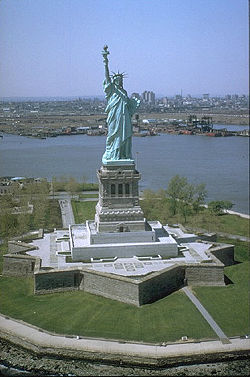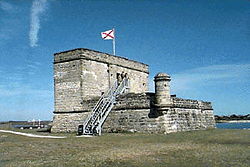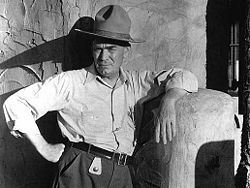U.S. National Monument
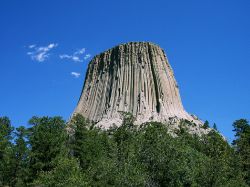
A National Monument in the United States is a protected area that is similar to a national park (specifically a U.S. National Park) except that the President of the United States can quickly declare an area of the United States to be a national monument without Congressional approval. National monuments receive less funding and afford fewer protections to wildlife than national parks do.
Another difference between a national monument and national park is the amount of diversity in what is being protected; national monuments aim to preserve at least one unique resource but do not have the diversity of a national park (which are designed to protect a host of unique features). However areas within and extending beyond, national parks, monuments or even national forests can be part of wilderness areas, which have an even greater degree of protection than a national park would alone, although wilderness areas managed by the USDA Forest Service and U.S. Bureau of Land Management often allow hunting.
National monuments are managed by the National Park Service, USDA Forest Service, United States Fish and Wildlife Service or by the Bureau of Land Management.
The power to grant national monuments comes from the Antiquities Act of 1906. President Theodore Roosevelt used the act to declare Devils Tower in Wyoming the very first national monument. His action was prompted by his fear that Congress' pace was slow enough to allow ruination of the site before it could come under protection.
History
Birth of Antiquities Act
The Antiquities Act of 1906, officially An Act for the Preservation of American Antiquities (16 USC 431-433), is an act passed by the United States Congress and signed into law by President Theodore Roosevelt on June 8, 1906 giving the President of the United States authority to restrict the use of particular public land owned by the federal government by executive order, bypassing Congressional oversight.
The Antiquities Act resulted from concerns about protecting mostly prehistoric Indian ruins and artifacts — collectively termed "antiquities" — on federal lands in the West, such as at Chaco Canyon, New Mexico. Removal of artifacts from these lands by private collectors — "pot hunters," in the language of the time — had become a serious problem by the end of the 19th century. In 1902, Iowa Congressman John F. Lacey, who chaired the House Committee on the Public Lands, traveled to the Southwest with the rising anthropologist Edgar Lee Hewett, to see for himself the extent of the pot hunters' impact. His findings, supported by an exhaustive report by Hewett to Congress detailing the archaeological resources of the region, provided the necessary impetus for the passage of the legislation.
The Act was intended to allow the President to set aside certain valuable public natural areas as park and conservation land ("National Monuments"). It also allows him to reserve or accept private lands for that purpose. The intention is to protect all historic and prehistoric sites on United States federal lands and to prohibit excavation or destruction of these antiquities. With this act, this can be done much more quickly than going though the Congressional process of creating a National Park. The Act states that areas of the monuments are to be confined to the smallest area compatible with the proper care and management of the objects to be protected.
Some areas designated as National Monuments have later been converted into National Parks, or incorporated into existing National Parks.
The Act has been used over one hundred times since its passage. Its use frequently creates significant controversy.
The Antiquities Act of 1906 resulted from concerns about protecting mostly prehistoric Native American ruins and artifacts — collectively termed "antiquities" — on federal lands in the West. It authorized permits for legitimate archaeological investigations and penalties for persons taking or destroying antiquities without permission. And it authorized presidents to proclaim "historic landmarks, historic and prehistoric structures, and other objects of historic or scientific interest" as national monuments — "the limits of which in all cases shall be confined to the smallest area compatible with the proper care and management of the objects to be protected."
So it was originally expected that national monuments would be proclaimed to protect prehistoric cultural features or antiquities and that they would be small. Yet the reference in the act to "objects of ... scientific interest" enabled President Theodore Roosevelt to make a natural geological feature, Devils Tower, Wyoming the first national monument three months later. Among the next three monuments he proclaimed in 1906 was Petrified Forest in Arizona, another natural feature (Congress would later make it into a national park).
The expectation that national monuments would be small was also soon overcome. In 1908 Roosevelt again used the act to proclaim more than 800,000 acres (3,200 km²) of the Grand Canyon as a national monument — a very big "object of scientific interest." And in 1918 President Woodrow Wilson proclaimed Katmai National Monument in Alaska, comprising more than a million acres (4,000 km²). Katmai was later enlarged to nearly 2.8 million acres (11,000 km²) by subsequent Antiquities Act proclamations and for many years was the largest national park system unit. Petrified Forest, Grand Canyon, and Katmai were among the many national monuments later converted to national parks by Congress.
There was no significant Congressional opposition to this expansive use of the Antiquities Act in Arizona and Alaska - perhaps in part because Arizona and Alaska were then only territories without representation in Congress. Substantial opposition did not materialize until 1943, when President Franklin D. Roosevelt proclaimed Jackson Hole National Monument in Wyoming. He did this to accept a donation of lands acquired by John D. Rockefeller, Jr., for addition to Grand Teton National Park after Congress had declined to authorize this park expansion. Roosevelt's proclamation unleashed a storm of criticism about use of the Antiquities Act to circumvent Congress. A bill abolishing Jackson Hole National Monument passed Congress but was vetoed by Roosevelt, and Congressional and court challenges to the proclamation authority were mounted. In 1950, Congress finally incorporated most of the monument into Grand Teton National Park, but the act doing so barred further use of the proclamation authority in Wyoming.
Since 1943 the proclamation authority has been used very sparingly, and seldom without advance Congressional consultation and support. In 1949, for example, President Harry S. Truman proclaimed Effigy Mounds National Monument to accept a donation of the land from the state of Iowa, at the request of Iowa's delegation. On those rare occasions when the proclamation authority was used in seeming defiance of local and congressional sentiment, Congress again retaliated. Just before he left office in 1961, President Dwight D. Eisenhower proclaimed the Chesapeake and Ohio Canal National Monument after Congress had declined to act on related national historical park legislation. The chairman of the House Interior Committee, Wayne Aspinall of Colorado, responded by blocking action on subsequent C & O Canal Park bills to the end of that decade.
The most substantial use of the proclamation authority came in 1978, when President Jimmy Carter proclaimed 15 new national monuments in Alaska after Congress had adjourned without passing a major Alaska lands bill strongly opposed in that state. Congress passed a revised version of the bill in 1980 incorporating most of these national monuments into national parks and preserves, but the act also curtailed further use of the proclamation authority in Alaska.
The proclamation authority was not used again anywhere until 1996, when President Bill Clinton proclaimed the Grand Staircase-Escalante National Monument in Utah. This action was widely unpopular in Utah, and bills were introduced to further restrict the president's authority. To date none of them has been enacted. Most of the 16 national monuments created by President Clinton are managed by the Bureau of Land Management, not by the National Park Service. The ones managed by the Park Service are Governors Island National Monument, Virgin Islands Coral Reef National Monument, and Minidoka Internment National Monument.
George W. Bush proclaimed two very different monuments in 2006, the hundredth anniversary of the Antiquities Act. African Burial Ground National Monument is a tiny archeological site in New York City. Northwestern Hawaiian Islands National Monument protects roughly 140,000 square miles (36,000 km²) of the Pacific Ocean—larger than all of America's national parks combined.[1]
Presidents have used the Antiquities Act's proclamation authority not only to create new national monuments but to enlarge existing ones. For example, Franklin D. Roosevelt significantly enlarged Dinosaur National Monument in 1938, Lyndon B. Johnson added Ellis Island to Statue of Liberty National Monument in 1965, and Jimmy Carter made major additions to Glacier Bay and Katmai National Monuments in 1978.
See also
- List of National Monuments of the United States
- List of U.S. National Forests
- List of areas in the National Park System of the United States (includes list of NPS-managed National Monuments)
- List of U.S. wilderness areas
- List of miscellaneous U.S. public areas
Template:Registered Historic Places
Notes
- ↑ Joshua Reichert and Theodore Roosevelt IV. Treasure Islands. Retrieved June 15, 2006.
ReferencesISBN links support NWE through referral fees
- National Park Service. National Monument Proclamations under the Antiquities Act Retrieved May 8, 2008.
- Orbitz - GORP. Top U.S. National Monuments Retrieved May 8, 2008.
- Williams, Christopher. November 10, 1999. National Monuments - In the fifty states, our nation's capital, and US territories Private Work. Retrieved May 8, 2008.
- Shafer, C. L. 1999. "History of selection and system planning for US natural area national parks and monuments: beauty and biology." BIODIVERSITY AND CONSERVATION. 8 (2): 189-204.
- United States, and International Council on Monuments and Sites. 1997. U.S. World Heritage Sites. [Washington, D.C.?]: U.S. Dept. of the Interior, National Park Service.
Credits
New World Encyclopedia writers and editors rewrote and completed the Wikipedia article in accordance with New World Encyclopedia standards. This article abides by terms of the Creative Commons CC-by-sa 3.0 License (CC-by-sa), which may be used and disseminated with proper attribution. Credit is due under the terms of this license that can reference both the New World Encyclopedia contributors and the selfless volunteer contributors of the Wikimedia Foundation. To cite this article click here for a list of acceptable citing formats.The history of earlier contributions by wikipedians is accessible to researchers here:
The history of this article since it was imported to New World Encyclopedia:
Note: Some restrictions may apply to use of individual images which are separately licensed.
